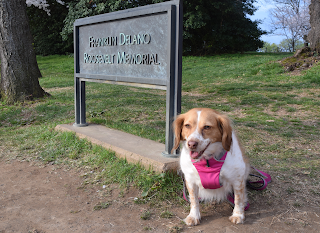
PawsGo
Exploring the Cherry Blossoms
The
flowering trees that surround the Tidal Basin and frame so many of our national
monuments are beautiful. You can see the
puffs of light pink as you drive across the 14th Street Bridge from
Virginia, or past the museums that line the National Mall. Yes, they are delightful. But we dread them because arrival of the
cherry blossoms means one thing we really hate – TRAFFIC.
Living and
working in D.C., you welcome tourists.
D.C. is a great city – the majority of museums are free, there are
endless things to see and do, so we expect month after month of school groups
and vacationers. But cherry blossom
season takes tourists and traffic to an annual high, to the point that it has
been at least five years since I made the effort to take Boomer for a walk
around the Tidal Basin and see the trees.
My friend
Mandy and I were each already planning on taking the day off. So we made our plan to head out fairly early
in the morning, arriving at the Haines Point parking area just before 8:00
a.m. Lattes in hand, and our dogs Ella
and Boomer by our side, we started the 2.3 mile walk around the Tidal Basin.
Cherry
blossoms are not indigenous to Washington, D.C.
They are Japanese. Bringing
cherry trees to Washington, D.C. was the brainchild of a woman (of course)
named Eliza Scidmore and it took 20 years to make her idea a reality.
Eliza was a
real renaissance woman with a fascinating life.
Born in Iowa, she moved to
Washington, D.C. during the early part of the Civil War. She became a travel writer and a member of
the National Geographic Society. Through
her travels she developed a love for Japan and the Japanese spring time ritual
of cherry blossom viewing. Why not bring
this delightful ritual to D.C.?, she thought, so she petitioned the parks service
to plant the trees. It wasn’t until
First Lady Helen Taft heard her appeal that the project moved forward. A gift from Japan, the first trees were
planted on March 27, 1912.
Evidence of
the trees’ history and the Japanese influence can be seen as you walk around
the Tidal Basin. Small monuments and
plaques dot the walk way. Larger, more
current and modern monuments physically eclipse the small historic reminders,
but all the monuments large and small, old and new fit perfectly and complement
each other.
We quietly walk past the MLK memorial (no
dogs allowed) and gaze at its majestic stature.
Along the
way Boomer and Ella make friends with other dogs and get lots of attention from
passersby. It’s still fairly early. We see numerous photo shoots, both
professional and amateur, it’s a beautiful morning and the blossoms are near
their peak. As we approach the Jefferson Memorial, the
dogs are literally grabbed by a group of Chinese tourists and our own impromptu
photo shoot begins! We leave with a
sneaking suspicion that Boomer and Ella will end up in a Chinese whiskey ad or on a
billboard in Beijing!
It’s nice to
take the morning off, spend some time with your friend and wander through a bit
a history and a part of the city that you’d normally curse due to traffic. The cherry blossoms are indeed delightful!
To learn more about the cherry blossoms and the best time to visit check out the National Park Service website at www.nps.gov/cherry or Facebook and Twitter @nationalmallNPS
To learn more about Eliza Scidmore go to www.greatblooming.com

















